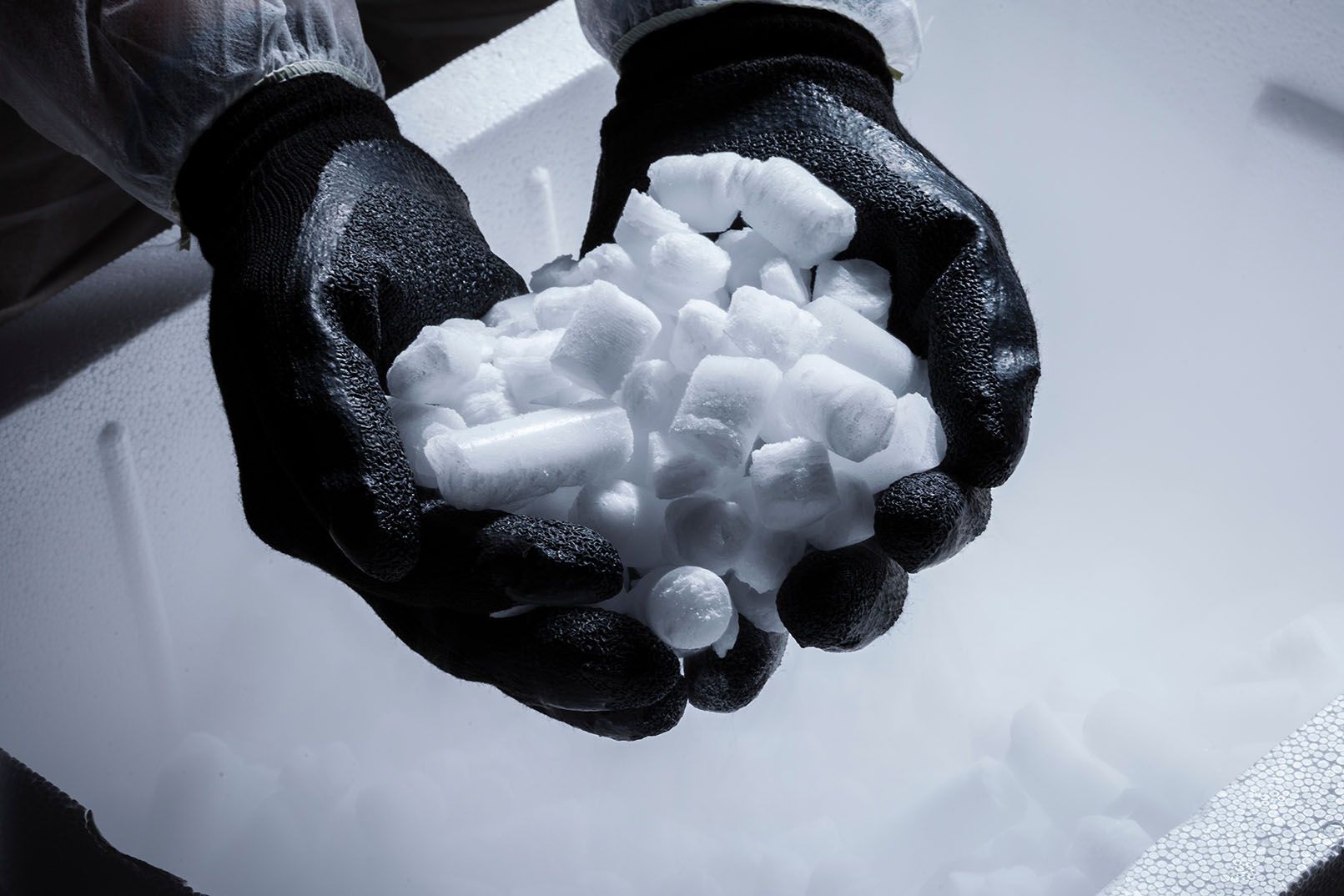

Articles
How To Store Dry Ice Overnight
Modified: August 16, 2024
Learn the best method on how to store dry ice overnight in this informative article. Keep your dry ice fresh and safe with these helpful tips.
(Many of the links in this article redirect to a specific reviewed product. Your purchase of these products through affiliate links helps to generate commission for Storables.com, at no extra cost. Learn more)
Introduction
When it comes to storing dry ice overnight, proper precautions and techniques are essential to ensure safety and preserve its longevity. Whether you need to store dry ice for a camping trip, medical transport, or simply for personal use, understanding the correct methods is crucial.
Dry ice is the solid form of carbon dioxide and is commonly used for its extremely cold temperatures. It can reach temperatures as low as -78.5 degrees Celsius (-109.3 degrees Fahrenheit), making it ideal for freezing and preserving perishable items. However, due to its unique properties, storing dry ice requires specific considerations to avoid potential hazards.
In this article, we will guide you through the steps and best practices for safely storing dry ice overnight. From choosing the right container to ensuring the ideal storage location, we will provide you with all the information you need to safely store and maintain dry ice.
Key Takeaways:
- Safely store dry ice overnight by choosing the right container, wrapping it with insulating materials, and finding an ideal storage location. Prioritize safety, monitor the temperature, and handle with care for effective preservation.
- Follow safety precautions, choose the right container, and insulate it properly to store dry ice overnight. Monitor the temperature, remove it safely, and prioritize safety to ensure effective preservation and usability.
Read more: How To Store Icing Overnight
Safety Precautions
Before we dive into the specifics of storing dry ice, it’s crucial to understand the safety precautions associated with handling this frozen substance. Although dry ice has several practical uses, it can pose risks if not handled properly.
1. Use gloves: Always wear insulated gloves or use tongs when handling dry ice. Direct contact with the skin can cause frostbite or injury due to extreme cold temperatures.
2. Adequate ventilation: Ensure that the storage area is well-ventilated to prevent the buildup of carbon dioxide gas. Carbon dioxide is released as dry ice sublimates, and high concentrations can be dangerous in enclosed spaces. Open windows or doors and use exhaust fans if possible.
3. Do not seal containers tightly: When storing dry ice, never seal containers or bags completely. As dry ice continues to sublimate, it releases gas, which can cause pressure to build up and potentially lead to container rupture or explosion. Leave some room for the gas to escape.
4. Label containers: Clearly label containers that hold dry ice to alert others of its presence. This helps prevent accidental contact and ensures that individuals are aware of the potential hazards.
5. Store in well-insulated containers: Use containers made of insulating materials such as Styrofoam or coolers specifically designed to store dry ice. These materials help maintain the low temperature and slow down the sublimation process.
6. Keep children and pets away: Dry ice can be attractive to children and pets due to its fog-like appearance. Ensure that it is stored in a secure location out of reach to prevent any mishaps.
By following these safety precautions, you can minimize the risks associated with storing dry ice and create a safer environment for yourself and others.
Choosing the Right Container
Selecting the appropriate container for storing dry ice is crucial for maintaining its temperature and preventing unnecessary sublimation. Here are some factors to consider when choosing the right container for your dry ice storage:
1. Material: Opt for containers made of materials with good insulation properties, such as Styrofoam or thick plastic. These materials help to minimize heat transfer and slow down the sublimation process of dry ice.
2. Size: Choose a container that is appropriately sized for the amount of dry ice you need to store. It should have enough space to accommodate the dry ice while leaving some room for expansion as it sublimates.
3. Lid: Ensure that the container has a tight-fitting lid to minimize airflow. This will help maintain a consistent temperature inside the container, prolonging the lifespan of the dry ice.
4. Leak-proof: It’s important to select a container that is leak-proof so that carbon dioxide gas does not escape, causing potential hazards and excessive sublimation.
5. Handles: Look for containers that have sturdy handles for easy transportation and handling.
6. Transparent or labeled: Having a transparent container or labeling it with a “Dry Ice” warning can help prevent accidental contact or mishandling by others who may not be aware of its unique properties.
Remember to always check the specifications provided by the container manufacturer to ensure its suitability for storing dry ice. Taking these factors into account will help you choose the right container and maintain the quality and longevity of your dry ice overnight.
Wrapping the Dry Ice
Once you have chosen the appropriate container, the next step is to properly wrap the dry ice to preserve its temperature and prevent excessive sublimation. Here’s how you can effectively wrap the dry ice:
1. Insulated bags: Consider using insulated bags or coolers designed for storing dry ice. These bags are lined with insulating materials, helping to maintain the low temperature and slow down the sublimation process.
2. Wrapping with newspaper or towels: If you don’t have access to insulated bags, wrap the dry ice in several layers of newspaper or towels. This additional insulation will help maintain a lower temperature for a longer period.
3. Double bagging: Place the wrapped dry ice in a sturdy plastic bag, making sure it is securely sealed. This extra layer helps to further insulate the dry ice and prevent any contact with other items in the container.
4. Avoid airtight wrapping: It’s important to note that the wrapping should not be airtight. Leave some room for the release of carbon dioxide gas, which is produced as dry ice sublimates. This will prevent excessive pressure build-up inside the container.
5. Quick and careful wrapping: When handling dry ice, work quickly and carefully to minimize direct exposure to the skin. Use insulated gloves or tongs to wrap the dry ice, ensuring your safety throughout the process.
Remember, the primary goal of wrapping the dry ice is to provide additional insulation and prolong its lifespan. By following these steps, you can effectively wrap the dry ice and ensure its optimal preservation during storage overnight.
Insulating the Container
Insulating the container is crucial for maintaining the temperature of the stored dry ice and minimizing sublimation. Proper insulation helps to slow down heat transfer from the surrounding environment, prolonging the lifespan of the dry ice. Here are some effective methods for insulating the container:
1. Styrofoam inserts or padding: If your container doesn’t already have built-in insulation, consider using Styrofoam inserts or padding. Cut the Styrofoam material to fit the inner walls of the container, providing an extra layer of insulation.
2. Bubble wrap or towels: Wrap the container with bubble wrap or place towels around it to create an additional insulating layer. This helps to minimize heat transfer from outside sources and maintain a consistent low temperature inside the container.
3. Use ice packs or frozen items: If available, place ice packs or frozen items alongside the dry ice within the container. This can further enhance insulation and help maintain the desired low temperature.
4. Close container tightly: Ensure that the container is tightly sealed to prevent warm air from entering and cold air from escaping. A well-sealed container helps to maintain a stable internal temperature and slows down the sublimation process.
5. Avoid frequent opening: Limit the number of times you open the container. Each time the container is opened, warm air can enter and cold air can escape, causing the dry ice to sublimate at a faster rate. Only open the container when necessary and for the shortest possible duration.
By implementing these insulation techniques, you can create a well-insulated storage environment for your dry ice, ensuring its longevity and optimal preservation overnight.
Store dry ice overnight in a well-insulated cooler with a lid to minimize sublimation. Place a towel or newspaper on top to further insulate and slow down the evaporation process. Keep the cooler in a well-ventilated area, as carbon dioxide can accumulate in enclosed spaces.
Read more: How To Store Royal Icing Overnight
Finding the Ideal Storage Location
Choosing the right storage location for your dry ice is essential in maintaining its temperature and quality overnight. Here are some factors to consider when finding the ideal storage spot:
1. Cool and dry area: Look for a cool and dry location to store your dry ice. Avoid areas that are exposed to direct sunlight, heat sources, or high humidity, as these conditions can accelerate the sublimation process.
2. Well-ventilated space: Ensure that the storage area has proper ventilation to allow the release of carbon dioxide gas that is produced as the dry ice sublimates. Good ventilation helps prevent the buildup of gas, reducing the risk of potentially hazardous conditions.
3. Dedicated storage area: It’s advisable to designate a specific area or container solely for dry ice storage. Keeping it separate from other perishable items or chemicals reduces the risk of cross-contamination and ensures the safety of both the dry ice and other materials.
4. Away from children and pets: Store dry ice in a location that is inaccessible to children and pets. The extreme cold temperature of dry ice can cause harm if mishandled or ingested, so it’s crucial to keep it out of reach.
5. Elevated surface: Place the container of dry ice on an elevated surface, such as a shelf or table. This helps to prevent accidental contact or spills and keeps the dry ice secure.
6. Secure and stable positioning: Ensure that the container is securely positioned to prevent it from tipping over or falling. A stable position reduces the risk of damage or injury and keeps the dry ice intact during storage.
By finding the ideal storage location that meets these criteria, you can maintain the desired temperature and quality of your dry ice overnight, ensuring its usability for the intended purpose.
Monitoring the Temperature
Monitoring the temperature during the storage of dry ice is crucial for ensuring its effectiveness and longevity. By keeping an eye on the temperature, you can make the necessary adjustments to maintain optimal conditions. Here are some methods for effectively monitoring the temperature:
1. Use a thermometer: Place a thermometer inside the container alongside the dry ice to monitor the temperature closely. Ensure that the thermometer is designed to withstand low temperatures and accurately measures the range required for dry ice storage.
2. Check regularly: Make it a habit to check the thermometer regularly to ensure that the temperature remains within the recommended range. This will help you identify any fluctuations that may require adjustments in insulation or storage location.
3. Keep a log: Maintain a temperature log to record the measurements at different intervals. This log will allow you to track any variations in temperature over time and make informed decisions based on the data collected.
4. Adjust insulation if needed: If the temperature begins to rise, indicating increased sublimation, consider enhancing the insulation around the container. Add additional insulation materials, wrap with blankets, or transfer the container to a cooler area to help maintain the desired low temperature.
5. Address issues promptly: If you notice any significant fluctuations in temperature or if the dry ice starts to sublimate at a faster rate than expected, address the issue promptly. This may involve adjusting the insulation, relocating the container, or adding more dry ice as needed.
By monitoring the temperature closely and taking the necessary actions, you can ensure the optimal storage conditions for your dry ice, prolonging its lifespan and preserving its effectiveness for any intended use.
Removing the Dry Ice Safely
When it comes time to remove the dry ice from storage, it is essential to do so safely to prevent any potential injury or mishap. Here are some guidelines to follow when removing dry ice:
1. Put on protective gloves: Before handling the dry ice, ensure you are wearing protective gloves. Insulated gloves or oven mitts are recommended to protect your hands from frostbite and extreme cold temperatures.
2. Open the container carefully: Open the container slowly and with caution. Do not forcefully open it, as the build-up of carbon dioxide gas may cause the lid to pop off or burst. Gently remove the lid while ensuring minimal exposure to air.
3. Use tongs or scoop: Avoid direct contact with the dry ice by using tongs or a scoop to handle and transfer it. This helps to prevent any potential burns or injuries caused by extreme cold temperatures.
4. Transfer the dry ice to a well-ventilated area: Once you have removed the dry ice from the container, transfer it to a well-ventilated area away from children and pets. Ensure that the area allows for the release of carbon dioxide gas as the dry ice sublimates.
5. Dispose of excess dry ice safely: If you have more dry ice than you need, do not dispose of it in a sink or toilet. Instead, allow the excess dry ice to sublimate in a well-ventilated area or contact a local waste management facility to inquire about proper disposal methods.
6. Store or use remaining dry ice appropriately: If you have unused dry ice, you can store it following the same guidelines mentioned earlier. Alternatively, if you need to use the dry ice immediately, ensure you have proper safety measures in place, such as gloves and a well-ventilated workspace.
By taking these precautions and following safe handling procedures, you can remove dry ice from storage without any accidents and ensure the well-being of yourself and those around you.
Conclusion
Storing dry ice overnight requires careful consideration and adherence to safety guidelines. By following the proper procedures and precautions, you can ensure the safe and effective preservation of dry ice for various purposes. Here’s a recap of the key points discussed:
– Safety precautions: Always prioritize safety by wearing gloves, ensuring proper ventilation, and labeling containers to alert others of the presence of dry ice.
– Choosing the right container: Select an insulated container with a tight-fitting lid to maintain the low temperature and prevent excessive sublimation.
– Wrapping the dry ice: Wrap the dry ice in insulating materials, such as newspaper or towels, to provide additional insulation and maintain its temperature.
– Insulating the container: Use Styrofoam inserts, bubble wrap, or towels to insulate the container and minimize heat transfer.
– Finding the ideal storage location: Look for a cool, dry, well-ventilated area away from children and pets to store your dry ice safely.
– Monitoring the temperature: Regularly check the temperature inside the container using a thermometer and adjust insulation or storage location as necessary.
– Removing the dry ice safely: Use protective gloves, open the container carefully, and transfer the dry ice to a well-ventilated area using tongs or a scoop.
By following these guidelines, you can ensure the longevity and quality of your dry ice overnight. Remember to always prioritize safety and handle dry ice with care to prevent any accidents or injuries. Whether you’re using dry ice for camping, medical transport, or any other purpose, adhering to these practices will help you make the most of its unique properties.
Frequently Asked Questions about How To Store Dry Ice Overnight
Was this page helpful?
At Storables.com, we guarantee accurate and reliable information. Our content, validated by Expert Board Contributors, is crafted following stringent Editorial Policies. We're committed to providing you with well-researched, expert-backed insights for all your informational needs.















0 thoughts on “How To Store Dry Ice Overnight”